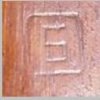Dark Skies
Member
I've never actually really bothered to interpret the markings on my Lee Enfield No.4 until today. The reason being that my rifle, whilst in excellent shape overall, has so many overstamping and proof marks that it's nigh on impossible to make out what they say - let alone chase down sources for the markings.
Anyhow today, for the first time ever, I noticed that on the top and bottom of the nose cap there is a squared capital letter 'S' within a square box looks a bit like this:
So I did a bit of digging around on the Net and through Ian Skennerton's Small Arms Indentification on the .303 and it looks like I have a Savage produced Enfield. Unfortunately I can't make out a 'US Property' stamping because the area where it's supposed to be appears to have been machined off - along with some other markings / numbers and then overstamped with a single serial number.
It looks like I have the earlier No4 Mk1 version because the No4 /1* had the bolt release moved forward and simplified whilst mine has the traditional button release just behind the stripper clip feed.
The general finish quality of the rifle seems better than British produced rifles I've seen. It also has a nicer stock a light oak colour instead of the very dark finished wood and the brass buttplate instead of steel. Oddly it has six groove rifling - I was under the impression Savage used two-groove. The bolt cocking piece is the three groove squared affair - not the round earlier version. It seems to have left service in 1952 - because all the serial numbers on the bolt, breech and body match and have F52 stamped next to it. These are a new serial number - I can just make out the remnants of the old one that had been polished off and then overstamped underneath. So I guess that any mix and matching was done prior it left service.
It's very difficult to pinpoint all the turning points that define a particular mark according to Skennerton - mine doesn't seem to tick all the boxes. Am I at least right about it being a Savage though?
Anyhow today, for the first time ever, I noticed that on the top and bottom of the nose cap there is a squared capital letter 'S' within a square box looks a bit like this:
So I did a bit of digging around on the Net and through Ian Skennerton's Small Arms Indentification on the .303 and it looks like I have a Savage produced Enfield. Unfortunately I can't make out a 'US Property' stamping because the area where it's supposed to be appears to have been machined off - along with some other markings / numbers and then overstamped with a single serial number.
It looks like I have the earlier No4 Mk1 version because the No4 /1* had the bolt release moved forward and simplified whilst mine has the traditional button release just behind the stripper clip feed.
The general finish quality of the rifle seems better than British produced rifles I've seen. It also has a nicer stock a light oak colour instead of the very dark finished wood and the brass buttplate instead of steel. Oddly it has six groove rifling - I was under the impression Savage used two-groove. The bolt cocking piece is the three groove squared affair - not the round earlier version. It seems to have left service in 1952 - because all the serial numbers on the bolt, breech and body match and have F52 stamped next to it. These are a new serial number - I can just make out the remnants of the old one that had been polished off and then overstamped underneath. So I guess that any mix and matching was done prior it left service.
It's very difficult to pinpoint all the turning points that define a particular mark according to Skennerton - mine doesn't seem to tick all the boxes. Am I at least right about it being a Savage though?







